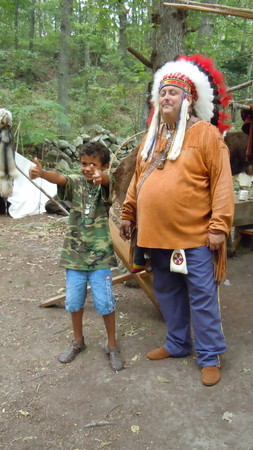By Jack Hitt
Among the newer tribes, this anxiety can get especially intense. All weekend at the Jaycee Fairgrounds, the Cherokees of Northeast Alabama whom I spoke to were quite nervous that I might pronounce them, as some put it, "ethnic frauds." Hickman, the genealogist, insisted upon knowing if I was "going to make fun of them." In the days leading up to the powwow, he called me repeatedly, his voice filled with panic. Hardly an hour went by over the weekend that the event's spokeswoman, Karen Cooper, didn't sidle up to ask me if there was anything she could do.
If you have to pretend you're something you're not for the tourists, you're not in the Indian "biz" for the right reason. If the choice is tourists + inauthentic culture or no tourists + authentic culture, the latter is infinitely preferable.
For more on the subject, see:
"3 Horses Sly Fox" teaches stereotypes
Half-naked "chief" in Mass. parade
The "honor" of a Plains chief
Debating Chief Zee
Below: "3 Horses Sly Fox" in Rhode Island.


No comments:
Post a Comment
Note: Only a member of this blog may post a comment.